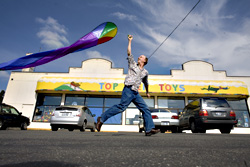Greenwood’s Top Ten Toys brings a politically correct agenda to a part of the consumer market that has remained notoriously resistant to enlightened-adult preferences. One of the largest independent toy stores in the country, it sticks to an aesthetic that the Uptight Seattleite would fully approve, offering educational, multicultural, ecological, traditional, and nonviolent toys. If it sounds at first like a stifling intrusion of adult values into child’s play, owner and manager Allen Rickert says the store’s success also comes from a lot of insight into what kids are all about.
The store’s ecological concerns apply not just to packaging, for example, but also to a toy’s reusability and versatility. As Rickert, who has a 2-year-old son, puts it: “What toys offer the most play value?” Anyone who remembers making a fort out of a cardboard box knows what that’s about. (Rickert and I commiserate on the overelaborateness that’s afflicted recent Lego design.) There’s a line of cooperative games—among them, some of the store’s best sellers—in which players work together to achieve a goal, rather than “I win and you lose. Kids hate that,” says Rickert.
There are science kits, robotics kits, model airplanes, puppets, a ton of craft and art supplies—anything that fuels a kid’s imagination rather than replaces it (no video games). Naturally, there’s no room for Barbies or Bratz, either—”You won’t see the big pink aisle here”—but dolls come in many skin tones, and there are foreign-language kids’ books. There’s plenty of pink, though, in the costume section, with tiaras, boas, and tutus for anyone who wants to play dress-up.
Top Ten encourages local toymakers—one ingenious example is an innovation in hula-hoop design: They’re filled with water to increase the centrifugal force and make them easier to use. (Rickert demonstrates.) Even the shelving is not industrial steel but knotted wood made by a disabled-persons’ collective in Vancouver. And to draw adults, who actually spend the money, there’s not only the good-works aspect but, powerfully, the “I remember that from kindergarten!” nostalgia factor. (Suddenly, I found myself asking, “Oooh, do you have Chinese jump ropes?”)
Rickert’s previous job, settling real estate disputes in divorce settlements, may have given him further experience in childlike behavior. When Amelia Rickert, who opened Top Ten in 1987, offered to sell the place to her brother 10 years later, he changed careers immediately and never looked back: “One week I was in my suit and tie, the next week in jeans, with people asking me advice about stuffed animals.”
Everyone on staff has an opinion, too. “We constantly debate where the line is on violence,” Rickert says wryly: guns vs. swords? Modern vs. historical? Right now, pirate-themed toys are OK, but the line shifts. Quality vs. affordability is another issue; those handcrafted wooden toys aren’t cheap—a lovely 6-inch-high giraffe goes for $20—and Rickert doesn’t want the place to come off as elitist. So next to the artisanal menagerie there’s the $2-and-under section full of marbles, superballs, and little rubber animals.
“Do you know what our top seller is by volume? Rocks.” Yep, agates and quartzes and the rest, bin after bin of them, some polished, some not. What could be more ecofriendly, less usurping of a kid’s imagination? It’s the mainstream makers of crap consumer goods that are the intrusive ones; Top Ten has thrived by figuring out what kids really want.—104 N. 85th St., 782-0098, www.toptentoys.com.







